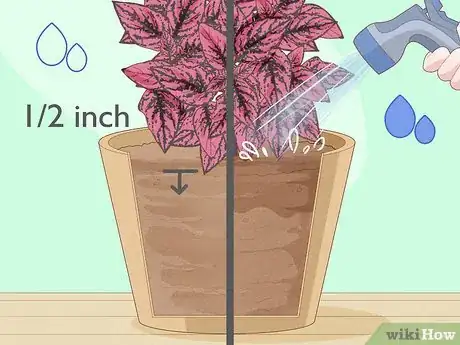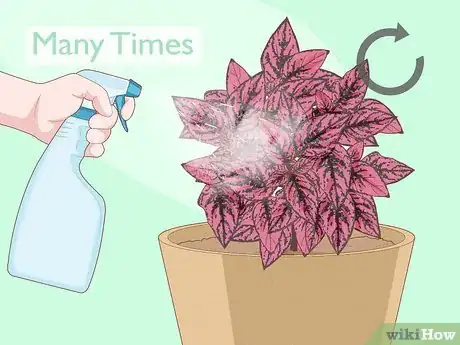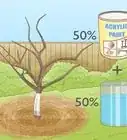This article was co-authored by Lindsey Swett and by wikiHow staff writer, Janice Tieperman. Lindsey Swett is a Plant Specialist and the Owner of Niche Plant Shop in Boston, Massachusetts. She has over a decade of experience working in several plant settings, including golf courses, public parks, and commercial garden centers. Her focus now is on helping plant owners care for their indoor plants. Lindsey holds a Master of Landscape Architecture from The University of Michigan.
There are 9 references cited in this article, which can be found at the bottom of the page.
This article has been viewed 7,970 times.
Hypoestes phyllostachya, more commonly known as polka dot plants, add a splash of color to your regular decor with their pink and green leaves. While you can grow these plants outdoors, they’re even more popular as an indoor plant. These plants have a short lifespan, and only tend to stay in bloom for around a year, but they’re easy to take proper care of in their prime.[1] With a few basic gardening supplies, you can help keep this freckle face plant in great condition.
Steps
Light, Water, and Temperature Requirements
-
1Display your polka dot plant in bright indirect light. Set your polka dot plant near a southern- or eastern-facing window, where it’ll get consistent low light throughout the day. Set these plants on a surface 2 to 3 ft (0.61 to 0.91 m) behind this window, so they can get partial shade without any direct sunlight.[2]
- Unfortunately, direct light can cause your plant to stress and fade, and may make the leaves curl.[3]
-
2Keep your plant in a humid, 75 °F (24 °C) area. Try to keep your plant in a temperature-controlled space with high humidity so it can really thrive. [4] Help create the ideal conditions by putting it in a humidity tray, or a bowl filled with stones and a little bit of water. Set the potted plant on top of the bowl, allowing the water from the humidity tray to evaporate directly into the plant.[5]
- This plant‘s native habitat is in places like Madagascar, Southeast Asia, and South Africa, which are likely more humid than your average living space.[6]
Advertisement -
3Water your plant when the top 1⁄2 in (1.3 cm) of soil is dry. Rub your fingers along the top of the potted soil and see if it feels damp or not. If the top 1⁄4 to 1⁄2 in (0.64 to 1.27 cm) of soil feels dry, soak the surface with some water.[7]
- Your plant should only have moist soil—if it’s overflowing with water, the roots can rot.
-
4Mist your plants multiple times each day. Fill a spray bottle with tap water and set it to a fine mist. Go over the entire plant with several squirts of water, coating the leaves with fine, tiny water droplets. Keep the spray bottle near your houseplants, so you can spritz over the leaves a few times throughout the day.[8]
- For instance, try misting your plant at least once in the morning, afternoon, and evening.
Pruning, Fertilizing, and Troubleshooting
-
1Prune your polka dot plants on a weekly basis. Polka dot plants need regular, weekly pruning, or else they can get pretty overcrowded. Find the 2 smallest leaves growing along the ends of each stem and pinch them off with your fingers.[9]
- Pruning your plant actually encourages it to become more healthy and bushy!
-
2Provide organic soil for your plant with good drainage. Check if your plant’s default soil drains well, or if water tends to sit on top of the dirt after a while. If necessary, replant your polka dot plant in a new pot with well-drained soil made with organic ingredients, like peat moss.[10]
- Look for organic potting soil in your local garden supply shop.
-
3Sprinkle an organic fertilizer over the soil once a month. Give your polka dot plant a boost each month with a small amount of fertilizer in its container.[11] Sprinkle the surface of the soil with some diluted liquid fertilizer around the same time each month, so your polka dot plant stays well-nourished.[12]
- Check the side of the fertilizer bottle to see how much water you need to dilute the product.
- Polka dot plants do best with a balanced fertilizer or a product where the nitrogen-phosphorus-potassium (NPK) ratio is even, like 10-10-10.[13]
-
4Replant the hypoestes if there’s root rot. Take a closer look at your plant’s roots if it doesn’t seem to be growing very well. If the entire root system looks brown and soft, you won’t be able to save your plant. However, if there are still white, healthy sections of the roots, trim away the rotted sections with sharp scissors and replant the polka dot plant in new soil.[14]
- Try to replant your polka dot plant within a few hours, so it has a better chance of recovering.
- Your plant may get root rot if you water it too much.[15]
-
5Spritz the leaves with fungicide if you notice powdery mildew. Powdery mildew looks like a white coating on your plant and can be pretty common on polka dot plant leaves.[16] Spritz the leaves with a fungicide, which can help get rid of the unwanted mildew. Take a few extra moments to spray over the bottom of the leaves, too.[17]
- Double-check the fungicide bottle for more specific instructions and precautions.
- Don’t use a sulfur-based fungicide for this—sulfur isn’t good for plants living in humid conditions.
Expert Q&A
-
QuestionDo Hypoestes like water?
 Lindsey SwettLindsey Swett is a Plant Specialist and the Owner of Niche Plant Shop in Boston, Massachusetts. She has over a decade of experience working in several plant settings, including golf courses, public parks, and commercial garden centers. Her focus now is on helping plant owners care for their indoor plants. Lindsey holds a Master of Landscape Architecture from The University of Michigan.
Lindsey SwettLindsey Swett is a Plant Specialist and the Owner of Niche Plant Shop in Boston, Massachusetts. She has over a decade of experience working in several plant settings, including golf courses, public parks, and commercial garden centers. Her focus now is on helping plant owners care for their indoor plants. Lindsey holds a Master of Landscape Architecture from The University of Michigan.
Plant Specialist Yeah, they do need to remain slightly more moist than other tropical plants, as they tend to dry out a little fast and get pretty dramatic about it. So I would recommend a moisture retaining soil. But be careful, as you don't want anything to stay super soggy.
Yeah, they do need to remain slightly more moist than other tropical plants, as they tend to dry out a little fast and get pretty dramatic about it. So I would recommend a moisture retaining soil. But be careful, as you don't want anything to stay super soggy.
Warnings
- Try not to overwater your polka dot plant! If there’s too much water in the soil, your plant can develop root rot, which will stop your plant from growing successfully.[20]⧼thumbs_response⧽
Things You’ll Need
- Water
- Spray bottle
- Bowl
- Stones
- Organic, balanced fertilizer
- Well-drained, organic soil
- Scissors
- Fungicide
References
- ↑ https://terrariumtribe.com/terrarium-plants/hypoestes-phyllostachya-polka-dot-plant/
- ↑ https://parade.com/845822/juliebawdendavis/grow-polka-dot-plant-in-your-indoor-garden/
- ↑ http://hort.ufl.edu/database/documents/pdf/shrub_fact_sheets/hypphya.pdf
- ↑ https://parade.com/845822/juliebawdendavis/grow-polka-dot-plant-in-your-indoor-garden/
- ↑ https://parade.com/848997/juliebawdendavis/providing-humidity-for-your-houseplants/
- ↑ https://wimastergardener.org/article/polka-dot-plant-hypoestes-phyllostachya/
- ↑ https://parade.com/845822/juliebawdendavis/grow-polka-dot-plant-in-your-indoor-garden/
- ↑ http://www.gardening.cornell.edu/homegardening/scened50f.html
- ↑ https://parade.com/845822/juliebawdendavis/grow-polka-dot-plant-in-your-indoor-garden/
- ↑ https://wimastergardener.org/article/polka-dot-plant-hypoestes-phyllostachya/
- ↑ http://www.gardening.cornell.edu/homegardening/scened50f.html
- ↑ https://wimastergardener.org/article/polka-dot-plant-hypoestes-phyllostachya/
- ↑ https://www.houseplant411.com/houseplant/polka-dot-plant-hypoestes-pink-splash-how-to-grow-plant-care-guide
- ↑ https://www.pennington.com/all-products/fertilizer/resources/recovering-from-root-rot
- ↑ https://parade.com/845822/juliebawdendavis/grow-polka-dot-plant-in-your-indoor-garden/
- ↑ https://wimastergardener.org/article/polka-dot-plant-hypoestes-phyllostachya/
- ↑ https://hgic.clemson.edu/factsheet/powdery-mildew/
- ↑ https://parade.com/845822/juliebawdendavis/grow-polka-dot-plant-in-your-indoor-garden/
- ↑ https://wimastergardener.org/article/polka-dot-plant-hypoestes-phyllostachya/
- ↑ https://parade.com/845822/juliebawdendavis/grow-polka-dot-plant-in-your-indoor-garden/



































































